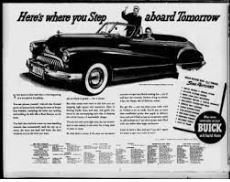McLuhan’s early writings, especially ‘American Advertising’ (1947), Typhon in America (1949, unpublished) and The Mechanical Bride (1951) reflect his detailed engagement with the popular environment, particularly with ads (but also with movies, radio, fashions, slang, etc). Here’s a Buick ad from 1947 that ran in newspapers nationally — McLuhan used it in Typhon II.1 along with other ads like MacLevy’s Figurama.
YOU know at first look that it’s the beginning of a wonderful friendship. You can picture yourself, with all that Fireball power to boss around, making the most of bright blue weather, trampling the miles into nothing and striding the hills like a Paul Bunyan on the loose. You feel like a kid with a new toy train handling controls that automatically send the top up or down, the front seat back and forth, the door windows to just the level you want. All of which is grand for a starter. But what means even more is that here you are stepping right square into tomorrow. Here in flowing fender lines, and neat, rich grille you travel in the eye-stopping style that is shaping the whole future of automobile design. You are not only style-right now, but are certain-sure to stay smartly in the swim for a long span of years to come. So what does it matter if the most we can assure you now is a spot on a Buick waiting list, you’ll still have the smartest, freshest thing on wheels when the happy day-of-delivery comes. But get this — you can place your order with or without a car to trade. You’ll pay no more than established prices that apply at delivery time, and you’ll find us just as courteously ready to talk business as if our showrooms were filled with cars rather than eager car-buyers. Come in, have a chat, and see if you don’t agree it’s smart to get your order in early.
McLuhan cited the underlined ad copy in Typhon:
This is from a car ad which might have been written for a super-matrimonial agency:
You know at first look that It’s the beginning of a wonderful friendship. You can picture yourself, with all that fireball power to boss around…. Here in flowing fenderlines, and neat rich grille you travel in the eye-stopping style…
Boy oh Boy! with bumpers that curve around your heart and a Hotchkiss drive! If one notices the catalogue of special engineering features which accompany many car ads it is as though one were reading the catalogue of design features for a girdle or bra. (Typhon in America, II.1)
The sheer number of ads referenced or quoted in any section of McLuhan’s writing in this period is noteworthy. But more important is the idea that is developing behind the scenes — the idea, namely, that everything in the human environment (= all experience)1 is the dynamic expression of underlying structural dominants which McLuhan would come to call, a full decade later, media.2
- “The human environment” has two aspects. There is physical nature, including the physical body of human beings, which is studied in the various physical sciences. This may be called the exterior landscape. Then there is the environment as experienced — “the entire diversity of civilized interests”, as McLuhan wrote in his 1950 UTQ review of Stallman — which McLuhan termed the interior landscape. It is not yet subject to scientific investigation — but must become so if we are to survive our own folly. (This interior landscape is not ‘interior’ in any spatial sense. It is ‘interior’ in that its constitution is determined in ways that cannot be abstracted from the psyche. Furthermore, this interior landscape is an entirely different field, actually fields, from those of the physical sciences. It is decidedly not the case, therefore, that the interior landscape might be investigated scientifically by collapsing it into one or more of the physical sciences.) ↩
- To compare, in physical sciences like chemistry and genetics, their elements (this was also Mendel’s name for what later were called ‘genes’) are inherently dynamic — they ex-press themselves as particular configurations in the experienced material environment with associated particular effects there. We come to understand it when we come to understand them — a process that took hundreds of thousands of years to be initiated consciously and that is ongoing as we speak. The imperative is to learn about them excluding us; excluding, that is, the limitations and distortions we bring to our experience of them. The whole point of experiment is to put a check on these. But what about those limitations and distortions themselves? Is the experienced material environment including us — the interior landscape — subject to a similar sort of collective investigation to that which we exercise in and on the exterior landscape excluding us? (This question puts a whole new spin on media as “extensions of the senses”!) McLuhan’s answer was that this is entirely possible and, furthermore, that this sort of interrogation is desperately needed today in a nuclear environment as a, or the, ‘strategy for survival’. And just as with the exterior landscape, the demand in regard to the interior one is to initiate the required investigation by specifying the underlying structure of its field or fields: “the medium is the message”. ↩
